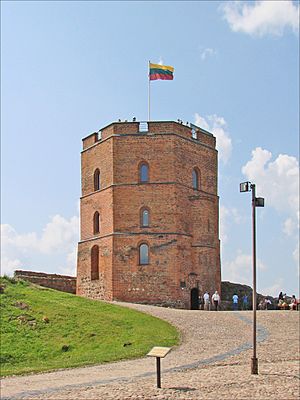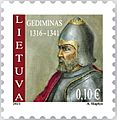Gediminas facts for kids
Quick facts for kids Gediminas |
|
|---|---|
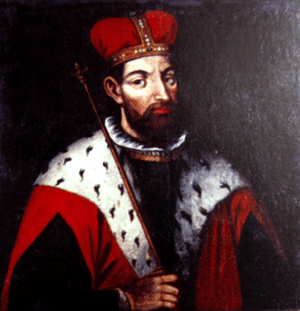
Grand Duke of Lithuania Gediminas as depicted in the Sapieha Genealogy in Kodeń, 1709
|
|
| Grand Duke of Lithuania | |
| Reign | 1316–1341 |
| Predecessor | Vytenis |
| Successor | Jaunutis |
| Born | c. 1275 |
| Died | c. 1341 Raudonė, Grand Duchy of Lithuania |
| Burial | Veliuona, Lithuania |
| Spouse | Vida Jaunė |
| Issue more... |
|
| Dynasty | Gediminids |
| Father | Butvydas |
Gediminas (born around 1275 – died December 1341) was a powerful ruler known as the Grand Duke of Lithuania. He led Lithuania from about 1316 until his death. Many people see him as the founder of the country as we know it. He greatly expanded its lands, which eventually stretched from the Baltic Sea to the Black Sea.
Gediminas is also famous for building Vilnius, the capital city of Lithuania. He started a royal family, the Gediminids, whose members later ruled other European countries like Poland, Hungary, and Bohemia. He was also known for protecting the traditional beliefs of his people. He used clever talks with the Pope and other Christian leaders to keep his country from being forced to become Christian.
Contents
Life of Gediminas
Becoming a Ruler
Gediminas was born around 1275. We do not know much about his early life. It is also unclear how he became the Grand Duke. He took power around 1316 when he was about 40 years old. He ruled for 25 years.
Some old stories say he was a servant to the previous ruler, Vytenis. Other stories say he was Vytenis's son. However, historians now believe he was likely a cousin or another relative. He became a very important leader for Lithuania.
Choosing a Path for His Country
Gediminas became the ruler of a large area. This included Lithuania proper, Samogitia, and other regions. But his lands were surrounded by powerful enemies. These were the Teutonic Knights and the Livonian Order. They had been fighting Lithuania for a long time.
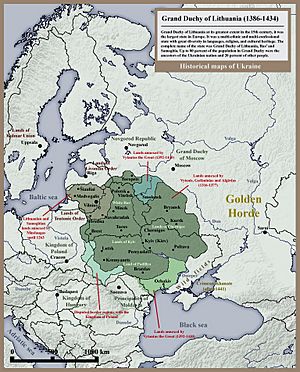
The Knights often attacked Lithuania, saying they wanted to convert the people to Christianity. Gediminas wanted to make Lithuania strong and secure. He decided to talk directly with the Holy See, which is the Pope's government. In 1322, he sent letters to Pope John XXII. He asked the Pope for protection against the Knights. He also mentioned that he had allowed Christian groups, like the Dominicans and Franciscans, to preach in Lithuania. He even suggested he might be baptized.
The Pope sent a good reply. So, in 1325, Gediminas sent letters to important European cities. He invited people from all walks of life to come and live in Lithuania. He promised them freedom to choose where to settle and to live by their own laws. He also invited priests and monks to build churches in Vilnius and Navahrudak.
In 1323, representatives from different Christian groups met in Vilnius. Gediminas repeated his promises. He said he would be baptized when the Pope's representatives arrived. A peace agreement was signed.
However, the Knights soon attacked again. They used Gediminas's offers to the Pope against him. Some of his own people, both Christians and pagans, were unhappy. The pagan Lithuanians worried he would abandon their ancient gods.
Gediminas then changed his mind about being baptized. He knew that the pagan beliefs were still very strong in Lithuania. He needed their support to fight the Knights. He secretly told the Pope's representatives that he had to delay his baptism. The Pope's representatives still trusted him. They told other countries not to attack Lithuania for four years.
Gediminas also made an alliance with Wladislaus Lokietek, the King of Poland. He had his daughter Aldona baptized so she could marry Władysław's son, Casimir III.
Gediminas understood that converting to Christianity could cause problems at home. The people in the main Lithuanian regions were strongly pagan. They, along with Orthodox Christians, even threatened to kill him if he converted. This had happened to an earlier ruler, Mindaugas, and Gediminas wanted to avoid that.
His main goal was to protect Lithuania from its enemies. He allowed Catholic priests to come for his Catholic subjects. But he punished anyone who tried to force pagan Lithuanians to convert. For example, around 1339–1340, he punished two Franciscan friars. They had preached against the Lithuanian religion. Gediminas ordered them to stop, and when they refused, they were killed.
Gediminas died as a pagan ruler. He had to balance the needs of his pagan relatives, his Orthodox Christian subjects, and his Catholic allies. It is still debated whether he truly wanted to convert or if it was a clever diplomatic move. The Jewish community in Lithuania also thrived during his rule.
Expanding the Territory
While defending against his northern enemies, Gediminas also expanded his lands to the south and east. He took advantage of conflicts between different Ruthenian (modern-day Belarus and Ukraine) regions. He conquered many cities in these areas. One important gain was the region of Halych-Volynia. He got this by marrying his son Lubart to the daughter of the Galician prince.
Gediminas won a big battle near Kiev, defeating Stanislav of Kiev. He then took over Kiev. After these victories, Lithuania's borders reached close to the Black Sea.
Gediminas was smart. He avoided war with the powerful Golden Horde. He also made an alliance with the growing Grand Duchy of Moscow. His daughter, Anastasia, married the Grand Duke Simeon of Moscow. He also helped the city of Pskov become independent from Great Novgorod.
Running the Country and His Death
Gediminas was a wise ruler. He protected both Catholic and Orthodox clergy. He made the Lithuanian army very strong. He built many fortresses and castles to protect his borders. He first moved the capital to Trakai, but around 1320, he made Vilnius the permanent capital.
Gediminas died in 1341. He was likely killed during a power struggle. He was cremated in a pagan ceremony in 1342. His favorite servant and some German slaves were also burned with him. This shows that Gediminas likely stayed true to his native Lithuanian beliefs. His interest in Catholicism was probably a way to gain allies against the Teutonic Order.
His son, Jaunutis, took over after him. But Jaunutis could not control the country. So, in 1345, his brother Algirdas took his place.
Gediminas's Legacy
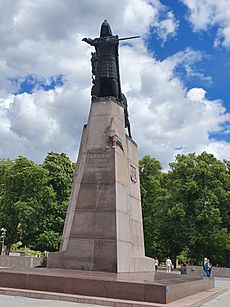
Gediminas founded a new royal family, the Gediminids. He also set the stage for Lithuania to become a much larger and more powerful state. Many people call him the "true" founder of the Lithuanian state.
There is a sculpture of him on the Millennium of Russia monument in Veliky Novgorod, unveiled in 1862.
He is also seen as the founder of Vilnius, the capital of Lithuania. A famous legend says that in 1322, Gediminas was on a hunting trip. He dreamt of an iron wolf howling on a hill. His priest, Lizdeika, told him the dream meant he should build a city there. So, Gediminas decided to build a fortress where the rivers Vilnia and Neris meet. This story has inspired many artists and writers.
Gediminas has been honored on a silver Litas coin in 1996. A Lithuanian folk music group, Kūlgrinda, released an album in 2009 called Giesmės Valdovui Gediminui, meaning "Hymns to Ruler Gediminas."
The name Gediminas is still very popular in Lithuania today. He is also celebrated in Belarus as an important historical figure. In 2019, a monument to Gediminas was put up in Lida.
Family
It is not certain how many wives Gediminas had. Some old writings mention three wives. However, most historians today believe he had one wife named Jaunė. She was an Eastern Orthodox Christian and died around 1344 or 1345.
Gediminas had seven sons and six daughters. His children included:
- Manvydas (born around 1288–died 1348)
- Narimantas
- Karijotas
- Jaunutis, who ruled Vilnius after his father's death
- Algirdas
- Kęstutis
- Vytautas (Gediminas's grandson)
- Maria, who married Dmitry of Tver
- Aldona, who married Casimir III of Poland
- Aigusta, who married Simeon of Moscow
- Elžbieta, who married Wenceslaus of Płock
- Eufemija, who married Boleslaw-Yuri II of Galicia
- Liubartas
Images for kids
-
Position of the Grand Duchy of Lithuania in Eastern Europe until 1434.
-
Gediminas monument in Cathedral Square, Vilnius
-
Gediminids - predecessors of the Jagiellonian dynasty 1521
See also
 In Spanish: Gediminas para niños
In Spanish: Gediminas para niños
- Columns of Gediminas




